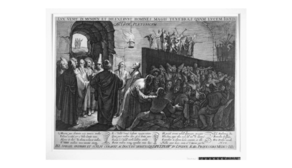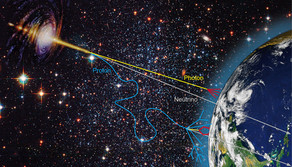New method for identifying different types of muons in Earth’s atmosphere
- News
- Allgemein

We are pleased to announce that our chair members, Pascal Gutjahr and Prof. Wolfgang Rhode, along with our former chair members Ludwig Neste, Dr. Mirco Hünnefeld, and Dr. Jean-Marco Alameddine, recently published a paper titled "Prompt and conventional high-energy muon spectra from a full Monte Carlo simulation via CORSIKA7." It introduces a new approach for tagging muons produced in Earth’s atmosphere, originating from the decay of different particles.
Muons can be generated in Earth’s atmosphere during an extensive air shower, which occurs when a high-energy cosmic particle enters the atmosphere. When this primary particle interacts with atmospheric molecules, it produces numerous secondary particles. Some of these can be muons.
These muons are categorized into conventional and prompt muons. The distinction is based on the particle in whose decay the muon is produced, called the parent particle. Conventional muons come from the decay of charged pions and kaons. They have longer lifetimes and are more likely to interact with the atmosphere before decaying. Prompt muons originate from the decay of other particles in the atmosphere and are called "prompt" because they have very short lifetimes and typically decay before interacting. Below approximately 1 PeV, conventional muons are predominant, but above around 1 PeV, prompt muons dominate.
Physical processes can be simulated to study them. The standard software for simulating extended air showers in astrophysics experiments is CORSIKA7, which models the propagation, interactions, and decays of particles in the Earth’s atmosphere. A new Python package called PANAMA has been developed to execute CORSIKA7 in parallel and parse it into user-friendly pandas dataframes. This facilitates the tagging of prompt particles.
In the study titled "Prompt and conventional high-energy muon spectra from a full Monte Carlo simulation via CORSIKA7," approximately 60 million air showers with energies from 100 TeV to 100 PeV were simulated. Muons in these showers were tagged as either prompt or conventional using PANAMA. For both the prompt and the conventional muons, the spatial and energy distribution, including the spatial spread of muons within a shower and the fraction of the primary particle’s energy they carry, were analyzed and compared. To validate these results, they were compared to those obtained using another software, Matrix Cascade Equation (MCEq), which calculates the muon flux at the Earth's surface numerically. The results matched well, confirming that the tagging for CORSIKA7 is suitable for studying muon fluxes and distinguishing between prompt and conventional muons.
To model hadronic interactions in extended air showers, hadronic interaction models are used. Continuous refinement of these models is crucial due to unresolved issues in astroparticle physics, such as the “muon puzzle.” This puzzle refers to the observation that ground-based and underground experiments detect significantly higher atmospheric muon fluxes than models predict. Testing these models with particle accelerators is challenging because cosmic rays have extremely high energies that cannot be reached in particle accelerators, and they are produced in the forward direction, where it is not possible to detect particles in an accelerator experiment. Therefore, astrophysical observations are used. The new tool, PANAMA, offers an easy way to probe and refine the hadronic interaction models further and will hopefully contribute to resolving issues such as the muon puzzle.

![[Translate to English:] [Translate to English:]](/storages/app-physik/_processed_/3/a/csm_APPGroupphoto2023_001_small_858e4405eb.jpg)

